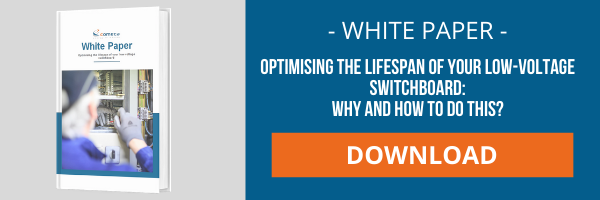How to choose a maintenance contract for your LV equipment?
Periodically maintaining your electrical installation allows you to ensure an optimal level of service for your equipment, limit the risks of production stoppages and control your direct and indirect costs. To this end, it is recommended that the manufacturer carry out regular maintenance: this is called preventive maintenance.
Subscribing to a maintenance contract allows you to benefit from the expertise and responsiveness of a qualified maintenance team, a response adapted to your operating constraints and your sector, a reduction in indirect costs linked to unplanned downtime, and defined rates for spare parts and labour within the framework of corrective maintenance services.
The maintenance contract allows you to extend the legal warranty period of the LV switchboard and defines the services provided by the manufacturer in terms of maintenance, checks, equipment control, etc. According to the standards in force, the contract ensures the conformity of the electrical equipment as well as regular diagnostics of their condition.
Clearly define the levels of maintenance required according to the frequency of the checks
The different levels of maintenance included in the Excelec reference framework and the operations to be carried out on your installation
The Excelec professional reference framework published by Gimelec is intended to help those responsible for the maintenance of an electrical installation, or the purchasers of this work, towards optimised maintenance in terms of both cost and quality.
Level 1: Routine maintenance. The interventions relating to the equipment are generally described in the manufacturer's maintenance manual.
Example: adjustments, checking levels, replacement of consumables
Level 2: Interventions requiring simple procedures and/or support equipment (integrated into the asset or external) of simple use and implementation. Interventions relating to equipment are generally described in the manufacturer's maintenance manual.
Example: replacement/exchange of adapting components, simple checks
Level 3: Operations requiring complex procedures and/or complex use or implementation support equipment.
Example: replacement of 'original manufacturer' parts, complex adjustments, realignments.
Level 4: Operations whose procedures involve mastery of a particular technique or technology and/or the use of specialised support equipment.
Example: technical upgrade, change in performance of a function, change in usage.
Level 5: Operations whose procedures involve know-how, using particular techniques or technologies, processes or industrial support equipment.
Example: general overhaul with complete dismantling of equipment, reconstruction, replacement of obsolete or worn-out goods.
Source: Excelec reference framework published by GIMELEC (in French only)
Periodicity of maintenance operations recommended by GIMELEC
The Excelec standard recommends an optimal frequency of these different services, adapted to the product in its life cycle, with a view to anticipating needs and optimising the overall cost.
| Family | Periodicity | Excelec level |
| Enclosure | Annual | 1 |
| Connections | Annual | 3 |
| Busbars | Every 3 years | 3 |
| Switchgear | Annual | 2 to 4* |
*depending on the equipment concerned and the type of service
For detailed information on the periodicity of each piece of equipment (in French only): consult the Gimelec reference guide.
Criteria for choosing a contract
The choice of contract depends on the services you require, particularly those that cannot be carried out internally by your own maintenance teams or that are not already covered by another contract (e.g. contract for global thermographic measurement of the site).
It is also linked to your requirements, to the geographical proximity of the service provider as well as its availability and flexibility to adapt to operational constraints.
The overall cost of the contract, for equivalent services, also remains a determining factor in the choice, in addition to the availability of spare parts.
Pre-contract ancillary service: the installation audit
In the case of an existing panel, the service provider carries out an audit of the installation before drawing up the contract: this audit determines the state of the equipment at the start of the contract, known as T0.
In the case of the purchase of a new switchboard, the audit is not necessary if the installation and electrical connection have been carried out at least under the supervision of the manufacturer.
Conclusion of the contract
Depending on the customer's internal process, a tender is issued on the basis of a specification listing the services to be provided.
The contract can also be concluded in the context of a commercial exchange based on the manufacturer's recommendations.
In Summary
Several levels of maintenance are defined by Gimelec and their frequency can vary according to the equipment and the phase of its life cycle. The choice of maintenance contract for your LV equipment therefore depends mainly on several criteria:
- the recommended maintenance levels (from 1 to 5)
- the maintenance intervals defined
- the availability of the equipment for maintenance
- the service requirements
- the cost of the services
- the proximity, availability and flexibility of the service provider
To guarantee the performance and life span of your switchboards, COMECA offers you its maintenance contracts, adapted to your needs, to plan and carry out maintenance operations on your LV switchboards.


